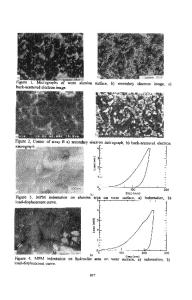Mechanical properties of highly porous alumina foams
- PDF / 352,666 Bytes
- 7 Pages / 584.957 x 782.986 pts Page_size
- 52 Downloads / 402 Views
The mechanical properties of porous ceramics are greatly influenced by their microstructure. Therefore, mechanical behavior of highly porous ceramics is different from that of dense ceramics. In this work, we evaluate different mechanical testing methods such as static compression, Brazilian disc test and 3-point bending on their suitability for comparison of highly porous ceramic materials. It is shown that 3-point bending is more suitable than static compression or Brazilian disc testing, as the material exhibits no critical crack propagation under compressive loading. With 3-point bending tests, a quantitative comparison of the mechanical properties of foams with different microstructures and porosities is possible. Under cyclic compression the foams exhibit a very high degree of crack tolerance in combination with preservation of their structural integrity even at high strains of 10%.
I. INTRODUCTION
Ceramic foams combine high chemical and thermal stability with low thermal conductivity and high surface area. Therefore they are ideal candidates for applications in the field of high-temperature insulation, and as catalyst carriers or filters for molten metals.1,2 In porous ceramics, the size and size distribution as well as interconnectivity and texture of the pores play an important role as they determine properties such as mechanical strength, thermal conductivity and permeability for gases and liquids. The microstructure of porous ceramics is controlled by their processing route and their appropriate parameters.3 Many processing routes to porous ceramics exist; most of them can be grouped in either one of the following methods: In the replica method, a polymeric sponge is impregnated with a ceramic suspension and after organic burnout, an open cell foam is obtained where the cell size is determined by the structure of template foam.4 In the fugitive phase method, a sacrificial pore former is used that often results in foams with highly ordered pore structures after removal of the pore former.5 In direct foaming, a gaseous phase is dispersed and stabilized in a liquid and both open and closed cell structures can be obtained after drying and sintering, depending on various processing parameters.6 Common to all methods, the introduced porosity will affect and alter the mechanical properties of the materials in one way or the other. As a result of this change in mechanical behavior, some mechanical measurement techniques commonly applied for dense ceramics might not be equally suitable for porous ceramics. The influence of the porosity on the mechanical strength has been studied in detail and Gibson and Ashby7 have a)
Address all correspondence to this author. e-mail: [email protected] DOI: 10.1557/jmr.2013.102 J. Mater. Res., Vol. 28, No. 17, Sep 14, 2013
http://journals.cambridge.org
Downloaded: 28 Mar 2015
presented a model to describe this influence. In their “beams and bars” model they describe the connection between porosity and various mechanical properties of cellular ceramics with open and closed-ce
Data Loading...










